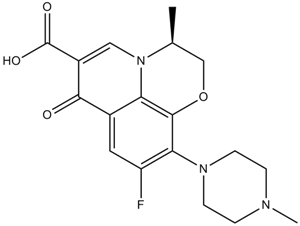Ofloxacin (Synonyms: DL-8280, WP0405) |
| Catalog No.GC12292 |
Fluoroquinolones,antibiotics
Products are for research use only. Not for human use. We do not sell to patients.

Cas No.: 82419-36-1
Sample solution is provided at 25 µL, 10mM.
Ofloxacin (Hoe-280) is a fluoroquinolone whose primary mechanism of action is inhibition of bacterial DNA gyrase.
Ofloxacin (Hoe-280) is a fluoroquinolone whose primary mechanism of action is inhibition of bacterial DNA gyrase. In vitro it has a broad spectrum of activity against aerobic Gram-negative and Gram-positive bacteria, although it is poorly active against anaerobes[1]. Ofloxacin (Hoe-280), like other 4-quinolones, is unusual among front line drugs available to treat bacterial infections since it affects bacterial DNA synthesis, rather than cell wall or protein synthesis[2].
Ofloxacin (Hoe-280) (20 mg/kg), norfloxacin (40 mg/kg), pefloxacin mesylate dihydrate (40 mg/kg)and ciprofloxacin (50 mg/kg) are administered by gavage twice daily for three consecutive weeks. 6 weeks after treatment, the test animals are euthanised and Achilles tendon specimens are collected. A computer monitored tensile testing machine was utilised for biomechanical testing. The mean elastic modulus of the control group was significantly higher than that of the norfloxacin and pefloxacin groups (p<0.05 and p<0.01, respectively). The mean yield force (YF) of the control group was significantly higher than those of ciprofloxacin, norfloxacin and pefloxacin groups (p<0.001, p<0.05 and p<0.01, respectively). The mean ultimate tensile force (UTF) of the control group was significantly higher than of the ciprofloxacin, norfloxacin, and pefloxacin groups (p<0.001, p<0.05 and p<0.01, respectively). Hyaline degeneration and fibre disarrangement were observed in the tendons of the ciprofloxacin, pefloxacin, and ofloxacin treated-groups, whereas myxomatous degeneration was observed only in the ciprofloxacin and pefloxacin groups[3].
References:
[1]. Todd PA, et al. Ofloxacin. A reappraisal of its antimicrobial activity, pharmacology and therapeutic use. Drugs. 1991 Nov;42(5):825-76.
[2]. Smith JT, et al. Ofloxacin, a bactericidal antibacterial. Chemotherapy. 1991;37 Suppl 1:2-13.
[3]. Olcay E, et al. Oral toxicity of pefloxacin, norfloxacin, ofloxacin and ciprofloxacin: comparison of biomechanical and histopathological effects on Achilles tendon in rats. J Toxicol Sci. 2011 Jun;36(3):339-45.
Average Rating: 5 (Based on Reviews and 37 reference(s) in Google Scholar.)
GLPBIO products are for RESEARCH USE ONLY. Please make sure your review or question is research based.
Required fields are marked with *




















